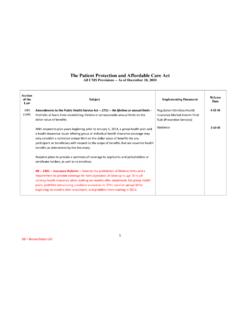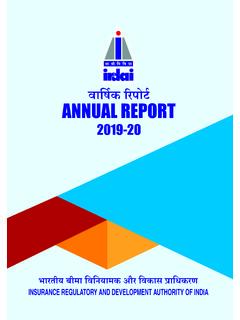Transcription of Analysis and Valuation of Insurance Companies
1 Analysis and Valuation of Insurance Companies Industry Study Number Two Center for Excellence in Accounting and Security Analysis Center for Excellence in Accounting and Security Analysis Columbia Business School established the Center for Excellence in Accounting and Security Analysis (CEASA) in 2003 under the direction of Professors Trevor Harris and Stephen Penman. The center aims to be a leading voice for independent, practical solutions for financial reporting and security Analysis , promoting financial reporting that reflects economic reality, and encouraging investment practices that communicate sound valuations. CEASA s mission is to develop workable solutions to issues in financial reporting and accounting policy; produce a core set of principles for equity Analysis ; collect and synthesize best thinking and best practices; disseminate ideas to regulators, analysts, investors, accountants, and management; and promote sound research on relevant issues.
2 Drawing on the wisdom of leading experts in academia, industry, and government, the center produces sound research and identifies best practices on relevant issues. CEASA s guiding criterion is to serve the public interest by supporting the integrity of financial reporting and the efficiency of capital markets. Located in a leading university with a mandate for independent research, CEASA is positioned to spearhead a discussion of issues, with an emphasis on sound conceptual thinking and without obstacles of constituency positions. More information and access to current research is available on CEASA s website at CEASA is supported by its generous sponsors General Electric, IBM, and Morgan Stanley and gratefully acknowledges the support of these organizations and their recognition of the need for excellence in accounting and security Analysis . Industry Study Comment These studies are intended to provide readers with a comprehensive review of the pertinent accounting conventions, academic literature, and approaches to security Analysis .
3 This paper does not necessarily reflect the views of the center s advisory board or the center s sponsors. Analysis AND Valuation OF Insurance Companies Doron Nissim; Ernst & Young Professor of Accounting and Finance, Columbia Business School Center for Excellence in Accounting & Security Analysis November 2010 1 Table of Contents Overview .. 2 1. Business .. 3 Activities and Organization .. 3 Products and Services .. 20 Distribution Channels .. 25 Competition .. 28 Regulation .. 30 Taxation .. 40 Risks and Risk Management .. 44 2. Financial Reporting and Line-Item Analysis .. 68 Common-Size Financial Statements .. 71 Insurance Reserves and Related Expenses .. 76 Revenue and Related Accruals .. 95 Deferred Policy Acquisition Costs and Related Expenses .. 97 Reinsurance .. 100 Investment Assets .. 103 Separate Accounts .. 110 111 Derivatives .. 115 3. Valuation .. 120 What Drives Value? .. 120 Profitability.
4 123 Accounting Quality .. 131 Growth .. 134 Cost of Equity Capital .. 138 Macro, Industry-Wide, and Line-Specific Drivers .. 143 Valuation Models .. 145 Conclusion .. 162 References .. 163 Acknowledgments .. 178 2 Overview During 2008 and 2009, the Insurance industry experienced unprecedented volatility. The large swings in insurers market valuations, and the significant role that financial reporting played in the uncertainty surrounding Insurance Companies during that period, highlight the importance of understanding insurers financial information and its implications for the risk and value of Insurance Companies . To facilitate an informed use of insurers financial reports, this manuscript reviews the accounting practices of Insurance Companies , discusses the financial Analysis and Valuation of insurers, summarizes relevant insights from academic research, and provides related empirical evidence. The paper contains three sections.
5 The first section describes the Insurance business, including activities and organization of Insurance Companies , products and services, distribution channels, competition, regulation, taxation, and risks and risk management. The second section discusses how Insurance activities are reflected in financial reports. Specifically, for each key line item from insurers financial statements, the study provides evidence on the economic significance of the item, reviews the related US accounting principles, discusses earnings quality issues, describes analyses and red flags that inform on the item s quality, reviews selected research findings, and describes the primary differences between International Financial Reporting Standards (IFRS) and US GAAP. Building on the discussion and analyses in the previous two sections, the third section addresses the Valuation of Insurance Companies .
6 The section starts by discussing the primary drivers of insurers intrinsic value, including profitability, growth prospects and cost of equity capital, as well as accounting quality indicators that inform on the reliability of the measured drivers. It then describes relative and fundamental Valuation models that translate those fundamentals into value estimates. Finally, in the context of fundamental Valuation models, the study presents a template for forecasting the key financial statement line items of Insurance Companies . This document is rather long and its efficient use, therefore, requires an understanding of the structure and content of the different sections. The first two sections of the document are mostly descriptive, while the final section is primarily prescriptive. All three sections discuss academic papers, often with significant details. To increase the usefulness of the literature review, the papers are discussed in separate categories by main focus.
7 However, many of the studies provide evidence relevant to multiple categories. The subsections containing detailed discussions of academic research usually follow a summary of the main findings and can generally be skipped without loss of continuity. 3 1. Business This section describes the business of Insurance . It is divided into seven subsections: the primary activities and organization of Insurance Companies (subsection ), the products and services offered by Insurance Companies ( ), distribution channels ( ), competition ( ), regulation ( ), taxation ( ), and risks and risk management ( ). Activities and Organization Insurance provides economic protection from identified risks occurring or discovered within a specified period. Insurance is a unique product in that the ultimate cost is often unknown until long after the coverage period, while the revenue premium payments by policyholders are received before or during the coverage period.
8 Insurance contracts are classified as either property and casualty (PC) or life and health (LH) policies: PC Insurance contracts providing protection against (a) damage to or loss of property caused by various perils, such as fire, damage or theft, (b) legal liability resulting from injuries to other persons or damage to their property, (c) losses resulting from various sources of business interruption, or (d) losses due to accident or illness. LH Insurance contracts that pay off in lump sums or annuities upon the insured s death, disability, or retirement. Some Insurance policies, primarily health-related policies, have both PC and LH characteristics and can therefore be classified as either PC or LH. Most Insurance Companies specialize in either PC or LH Insurance , but some have significant operations in both segments. In addition, while many insurers underwrite reinsurance policies ( Insurance sold to insurers), some focus on reinsurance as their core activity.
9 Insurers increasingly offer products and services that involve little or no Insurance protection , such as investment products and fee-based services. The industry also includes Companies that provide Insurance brokerage services (sourcing of Insurance contracts on behalf of customers). Reflecting this variation in activities, the Global Industry Classification (GIC) system classifies Insurance Companies as follows: Life and Health Insurers (40301020) Companies providing primarily life, disability, indemnity or supplemental health Insurance . This category excludes managed health care Companies , which are included in the Health Care sector. Examples include MetLife Inc. (MET), Prudential Financial (PRU), AFLAC Inc. (AFL), Lincoln National Corp. (LNC), Unum Group (UNM), and Torchmark Corp. (TMK). Property and Casualty Insurers (40301040) Companies providing primarily property and casualty Insurance .
10 Examples include Berkshire Hathaway Inc. (BRK-A&B), Allstate Corp. (ALL), The Travelers Companies Inc. (TRV), Ace Limited (ACE), The Chubb Corporation (CB), Progressive Corp. (PGR), and CNA Financial Corp. (CNA). Multi-line Insurers (40301030) Companies with diversified interests in life, health, property and casualty Insurance . Examples include American International Group Inc. (AIG), Hartford Financial Services Group Inc. (HIG), and Assurant Inc. (AIZ). 4 Reinsurers (40301050) Companies providing primarily reinsurance. Examples include Reinsurance Group of America Inc. (RGA), Everest Re Group Ltd. (RE), PartnerRe Ltd. (PRE), Arch Capital Group Ltd. (ACGL), Transatlantic Holdings Inc. (TRH), and ReinsuranceRe Holdings Ltd. (RNR). Insurance Brokers (40301010) Companies providing Insurance and reinsurance brokerage services. Examples include AON Corporation (AON), Marsh & Mclennan (MMC), Willis (WSH), Arthur J Gallagher & Co.
















